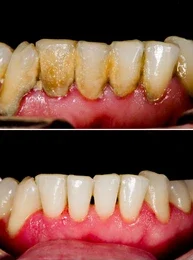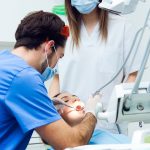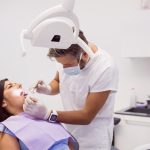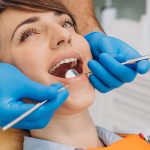
GINGIVAL RECESSION TREATMENT
What is gum recession?
Gum recession is a form of gum disease. It happens when your gum tissue pulls away from
your teeth, exposing the roots underneath. This makes your teeth more vulnerable to cavities.
Your teeth can become more sensitive when brushing or when eating as well. Gum recession can
be mild, moderate or severe. It may affect one tooth or multiple teeth.
Who does gum recession affect?
While gum recession can affect people of all ages, it’s most common in people over 65. You’re
more likely to develop recession if you:
- Have periodontal disease.
- Had braces or other orthodontic treatment.
- Use chewing tobacco.
- Have a lip or tongue piercing.
- Brush your teeth aggressively.
How common is gum recession?
Gum recession is a common dental problem. In fact, approximately 88% of people over the age
of 65 have gum recession on one or more teeth.
Symptoms and Causes
What are the symptoms of gum recession?
The most apparent sign of gum recession is tooth root exposure. Other gum recession warning
signs include:
- Pain or discomfort near your gum line.
- Sensitivity to heat, cold and sweets.
- Sensitivity when brushing and flossing your teeth.
- Sensitivity during dental cleanings.
Left untreated, gum recession can lead to other serious oral health problems, such as bone loss,
tooth mobility or feeling “wiggly” or even tooth loss. If you notice any of the symptoms listed
above, schedule an appointment with your dentist right away.
What causes recession of gums?
Your gums may recede for a number of reasons. Gum recession causes include:
- Brushing too hard or too aggressively.
- Dental plaque or tartar buildup.
- Periodontal disease.
- Trauma or injury to your gum tissue.
- Abnormal tooth positioning (misalignment).
- Smoking or chewing tobacco use.
- Lip and tongue piercings.
Oftentimes, poor oral hygiene is a contributing factor to gum recession, but this isn’t always the
case. Many people simply have a genetic predisposition to thin gum tissue.
No matter the cause of your gum recession, timely diagnosis and treatment can help prevent
long-term oral health problems.
Diagnosis and Tests
How is gum recession diagnosed?
Your dentist can diagnose gum recession during a routine examination. They’ll measure the
amount of gum recession on each tooth using a special instrument called a periodontal probe.
Bone loss is common in areas of gum recession. For this reason, your dentist will also measure
the periodontal pockets around each tooth. Healthy pockets measure between 1 and 3
millimeters. With gingivitis, pockets measure 4 millimeters. If you have periodontal disease,
your pockets will measure 5 millimeters or higher.
Management and Treatment
Can gums grow back?
Unfortunately, receding gums can’t grow back. But, you can take steps to prevent gum recession
from worsening.
How can I reduce sensitivity caused by gum recession?
Many people with gum recession experience pain or sensitivity. This is because your tooth roots
aren’t covered with protective enamel. They’re covered with cementum, which isn’t as strong.
Your dentist can apply fluoride varnish or other desensitizing agents to reduce discomfort
associated with receding gums. You can also use a desensitizing toothpaste at home. Your dental
hygienist can use numbing agents to make you more comfortable during your dental cleanings as
well.
What’s the best toothpaste for gum recession?
As mentioned above, desensitizing toothpaste can help ease discomfort associated with gum
recession. Look for active ingredients like potassium nitrate, stannous fluoride, arginine and
strontium chloride. These ingredients help calm the nerves inside your teeth. Desensitizing
toothpaste is best when used long term, and it can take several weeks to start working.
How do they fix receding gums?
Gum recession treatment largely depends on what caused the condition. Mild cases of gum
recession may be improved with nonsurgical treatments, such as topical antibiotics, dental
bonding or orthodontics. In most instances, however, gum recession surgery is needed to fully
correct the problem.
Nonsurgical treatments
Nonsurgical treatments for gum recession may include:
- Topical antibiotics. If gum recession is from periodontal disease, your dentist or
hygienist will work with you on how to be more effective in cleaning your teeth. Scaling
and root planing (deep dental cleaning) can be done under local anesthesia to get rid of
harmful bacteria that cause gum disease that are deep under the gum line. Occasionally,
your periodontist (gum disease specialist) may recommend inserting an antibiotic directly
under your gums to help treat gum disease. - Dental bonding. Sometimes your dentist can camouflage the area of recession with
tooth-colored composite resin. This covers your exposed tooth root, making it less
noticeable and more comfortable. - Orthodontics. If a tooth is crooked, tipped or rotated, it can cause gum recession. In
these cases, braces could be an option. Once the tooth is moved into proper alignment,
the gum margin may correct itself over time.
Gum recession surgery
Gum graft surgery is the most predictable and long-lasting treatment option for gum recession.
Typically, a periodontist (gum specialist) performs this procedure.
During this surgery, a gum graft is used to replace your missing gum tissue. The graft usually is
taken from the roof of your mouth but occasionally can come from sterilized human donor tissue.
Once the gum graft is in the proper position, your surgeon stitches it into place. There are several
different types of gum grafting procedures. Your surgeon can help determine which one is right
for your situation. Today’s gum grafting procedures are minimally invasive.
How long does it take to recover from gum grafting surgery?
Your recovery time will depend on several factors, including how many teeth were treated,
where the gum graft came from and what type of grafting procedure was done. In most cases,
people who undergo gum recession surgery feel back to normal in about two weeks.
Your surgeon will provide you with detailed postoperative instructions. You should follow these
instructions closely to foster a comfortable, successful recovery.
Prevention
Can I prevent gum recession?
Gum recession can’t always be prevented, especially if you are genetically predisposed to thin
gum tissue. However, you can significantly reduce your risk of infection-related gum recession
by practicing proper teeth and gum care. For example:
- Brush your teeth thoroughly twice every day.
- Floss once daily.
- Use an antimicrobial mouthwash twice daily.
- Follow your dentist’s recommendation for teeth cleanings. (Many people can maintain
healthy gums with six-month cleanings, but some may need more frequent visits.) - Use a soft-bristled toothbrush.
- Don’t smoke or use chewing tobacco.
See your dentist if you notice any signs of gum recession.
Outlook / Prognosis
What can I expect if I have gum recession?
If your dentist notices that you have mild gum recession, they may try some nonsurgical
treatments, such as topical antibiotics or dental bonding. If you have moderate to severe gum
recession, they’ll likely refer you to a periodontist or oral surgeon for a gum grafting
consultation.
Is gum recession curable?
Gum recession can’t be cured. But, it can be successfully managed with proper treatment and care.
Living With
When should I see my healthcare provider?
If you notice that your teeth roots are more visible than they used to be — or if you have
increased teeth sensitivity — you could have gum recession. It’s important to call your dentist or
periodontist at the first sign of problems. The sooner gum recession is detected and treated, the
better chance you have of establishing optimal oral health.
What questions should I ask my healthcare provider?
Learning all you can about gum recession can help you avoid common problems and restore
your oral health. Here are some questions to ask your dentist:
- How advanced is my gum recession?
- Are there any nonsurgical options that could work for me?
- If not, what type of gum grafting surgery do you recommend?
- What are the chances of my gum recession coming back?
- How often should I have my teeth cleaned
- GUM DEPIGMENTATION
- What Is Gum Depigmentation?
- Gum depigmentation, gum bleaching, or whitening is a cosmetic procedure that brightens
the gums, giving you an aesthetically pleasing smile. There are several gum
depigmentation procedures: laser gum bleaching, scalpel gum depigmentation, and gum
grafting. Some surgeons also offer cryosurgery to treat gingival depigmentation. Each
procedure has a different recovery time, but the process is generally considered
minimally invasive. It is up to the dentist to decide on the gum depigmentation procedure,
depending on the reason for the pigmentation and the final result you are trying to
achieve. - Laser Gum Bleaching
Laser gum depigmentation involves vaporising and removing the top layer of the gum
tissue, thereby destroying the cells that produce melanin. As the new tissues form, they
appear pink and not the earlier shade. The entire procedure is done under local anesthesia
and has a short recovery time. The process is recommended only for patients with healthy
gums. - Scalpel Gum Bleaching
This is a traditional gum depigmentation procedure performed using a scalpel. The
dentist surgically removes the uppermost layer and the underlying layer of the connective
tissue while ensuring that nothing remains over the denuded area. This method is
economical but causes bleeding. You may have to cover the surgical site for around ten
days. Also, there’s a risk that the gums could pigment again. The scalpel method is often
preferred for gum depigmentation as it costs less and requires less equipment. - Gum Grafting
This treatment involves taking healthy gums from another area of the mouth and grafting
them on the discoloured gums. This is an invasive procedure that takes time to heal and is
usually performed to cover overexposed teeth. - Periodontal Flap Surgery
- When advanced gum disease (periodontitis) develops, your teeth are in danger: At
this stage, the ligaments and bone tissue that surround them are being destroyed, and youcould even begin losing teeth! If the disease can’t be controlled by non-surgical
treatments like cleaning and scaling, then periodontal flap surgery may be your best
treatment option. - Flap surgery is today’s leading method for treating and repairing periodontal pockets.
What are these “pockets?” They are areas below the gum line where gum tissue has
detached from the teeth, resulting in an uncleansable space where harmful bacteria can
proliferate. These bacteria cause inflammation of the tissues, resulting in sensitivity,
bleeding, and pain. Left untreated, they can cause a host of problems including gum
disease, loss of the tooth-supporting bone structure, and possibly even systemic (whole-
body) problems. - When periodontal pockets develop, the first step in treating them is usually via cleaning
and scaling (also referred to as root debridement) with a manual or ultrasonic instrument.
If this isn’t effective, then periodontal surgery is considered. Flap surgery isn’t a cure for
periodontal disease — but it helps create an environment that makes it easier to maintain
your periodontal health. And even if you’re prone to gum disease, proper professional
treatment and regular care at home can help keep your teeth healthy for as long as
possible. - The Goals of Flap Surgery
- One major objective of flap surgery is to eliminate or reduce the pocket itself. To access
it, a flap-like incision is made in the gum tissue. This allows us to remove diseased tissue
from inside the pocket, and lets us access the teeth’s root surfaces for a thorough cleaning,
helping to eliminate harmful plaque and calculus (tartar). Afterward, the "flap" is closed,
sealing the area. This begins the healing process, which takes place rapidly. - Another goal is the regeneration of periodontal ligament and bone tissue which may have
been lost to the disease. We use a variety of techniques to accomplish this, including
high-tech methods of bone grafting and chemicals referred to as growth factors. These
approaches help restore the gums to their normal form and function, and promote the
healthy and secure anchoring of teeth. - The Flap Surgery Procedure
- Flap surgery is typically done under local anesthesia, sometimes accompanied by oral
anti-anxiety medications; alternatively, it may be performed under intravenous conscious
sedation. After anesthesia has taken effect, a small incision is made to separate the gums
from the teeth. The outer gum tissue is gently folded back to give access to the roots and
the supporting ligament and bone tissue. - Next, the inflamed gum tissue can be removed, and the tooth roots can be cleaned; if
needed, the area may also be treated with antibiotics or other medications. Bone defects
can be repaired with grafting material, and proper regeneration of the periodontal
ligament can be encouraged by physical (barrier membranes) and chemical (growth
factors) methods. Finally, the incision is closed and the procedure is completed. - Performed by an experienced hand, state-of-the-art flap surgery has an excellent track
record and offers well-established benefits. It’s often the treatment of choice for relieving
periodontal disease and helping to maintain your oral health — and preserve your teeth.









